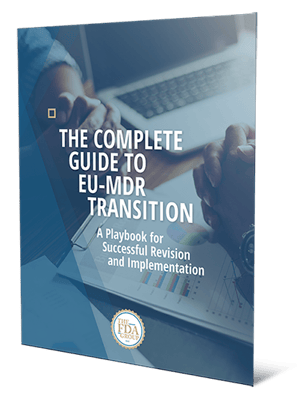The European Commission has released the first guidance for the upcoming Medical Device Regulations (EU MDR) and In Vitro Diagnostic Regulations (IVDR).
Both the EU MDR and IVDR replace the existing Directives, however, the new rules will only apply after a transitional period. For MDR, this period is three years after entry into force (spring 2020). For the IVDR, this period is five years after entry into force (spring 2022).
More recently in March of 2018, a document regarding the requirements for a future EU medical device nomenclature was endorsed at the meeting of the European Medical Devices Coordination Group (MDCG). Access the full document here.
In particular, this nomenclature is important for the development of EUDAMED—a collection of databases and electronic systems which will be established for collecting data.
A device must be linked to one of the nomenclature terms as part of its Unique Device Identification (UDI) data, making it possible to compare data from different devices within the same nomenclature group.
Specifically, in Annex VI, Part B, section 8 of the EU MDR, the medical device code is required to be provided by the manufacturer when entering data for the UDI Device Identifier (UDI-DI).
What are the Nomenclature Requirements in the EU MDR?
The recent medical device nomenclature guidance (MDCG 2018-2) offers information for creating a nomenclature system within the EU for future medical devices.
The guidance sets out the a number of important principles for creating a nomenclature system:
1. The nomenclature will be free to use for manufacturers
"...the future nomenclature shall be available free of charge to manufacturers and other natural or legal persons required by the Regulation to use that nomenclature, this meaning that no manufacturer or natural/legal person should be subject to fee or suffer from any discrimination, compared to other operators, in relation to the use of the nomenclature under the new Medical Device Regulations."
2. Names and codes should be present in EUDAMED
"It shall be therefore ensured that relevant names and codes are accessible (in full) in EUDAMED to all operators that are requested to provide the relevant UDI submissions.
Provisions in Chapter III and Annex VI of the new Regulations, and in particular the combination of Article 28(3) of the Regulation 745/2017 on medical devices and point 8 of part B of Annex VI, provide that moreover names and codes are publicly available in the UDI database (in EUDAMED)."
3. Policies and rules for updating, removing and creating of names and descriptions in the nomenclature must be sound and reflect regulators’ needs and the broader needs of the healthcare economy
"Policies/rules for update, removal and creation of names and descriptions in the nomenclature are to be sound and must reflect regulators’ and the wider healthcare economy needs. An EU regulatory team on nomenclature composed of regulators, to be established possibly as an MDCG sub-group, will review, determine (preferably within a global perspective) and validate those rules prior to designation decision and will continue to hold an advisory role on these matters. On a periodic basis, in accordance with a pre-defined procedure, and in consultation with the nomenclature provider, that group shall also provide feedback and advice on the governance of terms and descriptions, based, inter alia, on the requests received from economic operators and other stakeholders.
In the context of activities mentioned in the previous paragraph, it shall be aimed to ensure that the terminology structure used for it should not be unnecessarily granular and should not contain names that are only used by only a few economic operators or stakeholders, unless it is proven to be advantageous to regulators or the wider healthcare economy."
4. Systems should avoid unnecessary granularity and words and/or codes used only in a small set of EU economies
"[In reference to the activities mentioned previously,] it shall be aimed to ensure that the terminology structure used for it should not be unnecessarily granular and should not contain names that are only used by only a few economic operators or stakeholders, unless it is proven to be advantageous to regulators or the wider healthcare economy."
5. Future nomenclature should be designed and structured with hierarchies and should facilitate links with codes defining designation scope, QMS/QA certificates, and product portfolios
"The structure and design of the future nomenclature should facilitate the establishment of links with the codes defining Notified Bodies competence (designation scope) , the scope of medical devices QMS (Quality Management System)/QA (Quality Assurance) certificates, and product portfolios in the mandate of Authorised Representatives.
The nomenclature should have hierarchies by which terms and codes could be meaningfully grouped into categories and subcategories."
6. Nomenclature providers will need to have procedures and services in place that allow EUDAMED to be kept up-to-date at any time
"The future nomenclature system shall adequately support the functioning of the EUDAMED database and the functioning of the new Regulations as a whole. In this context, EUDAMED shall make available the most updated names/codes related information, to the benefit of operators and general public. Therefore, the nomenclature provider will need to have procedures and services in place that shall allow EUDAMED to be kept up-to-date at any time. When setting the procedure, in particular the frequency, related to the periodic review of nomenclature terms and descriptions, this shall be taken into account."
7. Systems/processes must be in place to periodically review terminology structure and content for updating
"System/processes shall be in place to periodically review the terminology structure and content to incorporate learning from ongoing experience with real-world use of device nomenclature (ex. EUDAMED, GUDID, registries) as well as from technological innovation."
Read more on MDR transition and compliance:
• The First Step to Transitioning to EU MDR Compliance
• A Quick-Guide to Clinical Evaluation Under EU MDR
• EU MDR Compliance & Transition: A Strategy for Implementation

Grab our free white paper and get a comprehensive step-by-step guide to building an effective EU MDR transition program, along with key changes and areas of focus.


